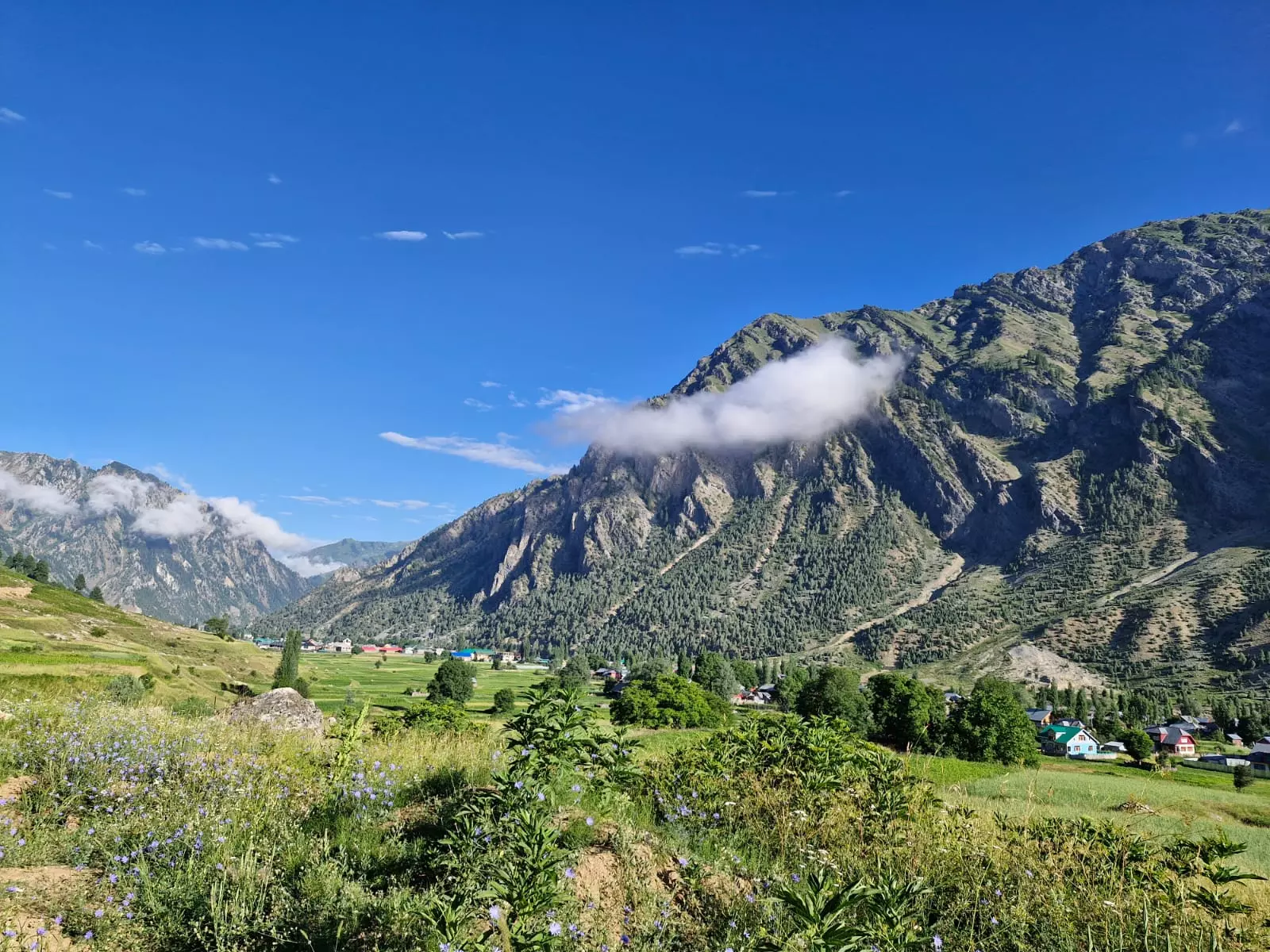Gurez - finding its identity in the tourism map
Gurez, the picture-perfect valley in Kashmir has more to offer. The remnants of the Silk Road, efforts to revive the Dardi identity, an alluring cocktail of history and myths, stories of lives divided by borders, and the resilience against the climate make Gurez a world of its own.

In our journey up towards the 11,667-foot-high Razdan pass in the north of Kashmir, we soak ourselves in the breeze that finds a way towards us through the tall deodar trees. The tall deodars, towering mountains, and the deep gorges keep reminding us that we are too small in the bigger scheme of things. We alight at the Razdan pass which gives us a profound view of an array of mountain tops. We chase the cuddly and wooly lambs grazing in the herd while conversing with the tall, sturdy, and lean shepherd who walks about 270 kilometres to Rajouri with his herd ahead of the winter and returns when the snow melts. The Army officer points towards a few mountaintops on the other side of the border. While I understand what it means for the soldiers on constant guard of the mountains, the irony in the inane division of the mighty mountains does not escape me.
Once we move past the Razdan pass, the road starts showing her dangerous streak with the jagged rocks protruding out on the one side and the cliff sans crash barriers or guard rails on the other. The blacktop having weathered away, the road is nothing but grey dust and gravel. We hold our breath when the vehicle navigates through narrow bends. However, the Border Roads Organisation has not lost its humour. There is no dearth of their boards with catchy phrases.
By then the Kishanganga river, also known as Neelam in Pakistan, starts showing up down the cliffs. She turns into a still emerald beauty as we reach the Kishanganga dam. Her matured demeanour starts becoming flirty and playful as we go farther up the catchment area. She is a sight to behold. Under the watchful blue sky, with the tall green mountains on guard, she lets loose her frothy white and turquoise blue waters that gurgle over the white pebbles and cobbles that sparkle in the summer sunlight.
As we keep admiring her beauty, Gurez starts appearing as a long line of white and blue tents on the flood plains of Kishanganga. Gurez is a rustic beauty surrounded by mountains and tiny villages of log houses perfectly blending with the landscape. The small-sized fields on the flood plains grow potatoes, kidney beans, green peas, and maize, while on the fringes, wild plants mark their territory by blooming blue, white, yellow, and pink flowers. The green meadows going up towards the deodar trees on the mountaintops are interrupted by the crystal-clear streams running down. The vivacious river flowing down is at the centre of all of these.
The visitors who just want to sit down and immerse themselves in the beauty around are interrupted and brought back to the harsh reality of possible incursions by the sight of barbed wires drawn along the border and the Army vehicles moving across. Despite being peaceful, the whole area is fortified by the watchful Army.
Gurez is part of the larger Dardistan, which extends to Gilgit-Baltistan in Pakistan-occupied Kashmir. Almost 70 per cent of Dardistan is now with Pakistan. The people of Gurez tell the sorry tales of their forefathers whose families were divided into two countries. Abid Hussain, an engineering graduate who runs a few resorts in Gurez, tells us the story of his grandfather, who had to forfeit his land and family in Gilgit after getting married to his grandmother, a native of Gurez, and how he wished to be buried close to his family land.
Gurez is not just a picturesque valley, it is also part of legends, history, and myths that add to its charm. The pyramid-shaped barren mountain peak Habba Khatoon which attains a golden hue as the sun sets against her in the evening sky, deserves a legend. The mountain is named after the celebrated poetess of Kashmir. According to history, the 16th-century Kashmir King Yousuf Shah Chak fell in love with Habba Khatoon, the beautiful poetess, whom he married after getting her divorced from her oppressive husband. Her poems of love and separation are still popular in Kashmir. When Chak was imprisoned by Mughal emperor Akbar, she wandered around in grief and her tears flowed down through the Habba Khatoon mountain in Gurez to form a spring that flows into the Kishanganga river.
Dardistan also has references in Mahabharata and Buddhist texts. A project funded by the Indian Army to revive the language and history of Gurez as part of Dardistan, is in the process of coming up with a script for the Shina language spoken in the region. According to researchers, who are part of this project and the Shina Cultural Centre, natives of Gurez lost the Shina script after the major part of the region came under Pakistan-occupied Kashmir. The language has words similar to Sanskrit unlike Kashmiri spoken in other parts of the state. The cultural centre also showcases the weaves, architecture, animals, festivities, food, and lifestyle that make Dards of Gurez unique.
Gurez also was part of the famous Silk Road of yesteryears and the residents claim that a few wooden bridges found in the valley date back to those times and were used by the traders who travelled by foot or on horseback.
The seemingly mundane life of the people in Gurez is no less than an adventure. We would see them in their fields, walking up the mountain to collect firewood like the ants that collect food for the rainy days. But when the winter winds start gusting and the green mountains of deodars turn white under the frozen snow, they move out of the valley like the migrating birds flocking tropical lakes. Before the Razdan pass and the mountain road gets blocked by snow and they are cut off from the mainland, a large majority of the population move out to the nearest town of Bandipora or to Srinagar. Those who choose to stay back, have to live the six winter months with the supplies left as the temperatures plummet up to 20 degree Celsius below freezing point and snow becomes 8 to 9 feet deep. In the log houses, the livestock is herded on the ground floor while the family stays on the first floor with the warmth provided by the firewood collected during the rest of the year.
However, when almost 70 per cent of the population moves out to the mainland, they are hit by infrastructural inadequacies. The unfinished roads and the lack of state-run public carriers are major impediments. They pay five times higher charges to a few private carriers to reach the mainland. “Even in the non-winter months, the supplies from the mainland become costlier by several times as they reach Gurez. The lack of skilled labour for construction works and high prices of raw materials also add to our woes,” said Hussain, who makes up for the inadequate facilities with his warm and winning smile and mild demeanour.
While Gurez Valley is increasingly finding its due place on the tourist map, it is not bereft of challenges. Due to costly supplies from the mainland, the resort owners have to depend on the local produce to feed the tourists. Haphazard and unplanned construction can potentially destroy the valley's pristineness, which draws nature lovers to it. Without proper sanitation facilities and plastic waste disposal, the Kishanganga River is losing its beauty. Discarded plastic bottles, containers and multi-colour polythene carry bags are ruining her charm. The wastewater flowing into the river in certain places is worrisome. The river is the lifeline of the valley and concerted efforts from the part of the residents and authorities to preserve her are crucial. The construction of roads, bridges, and tunnels has to strictly adhere to environmental norms and consider the carrying capacity of the mountains and valleys. Any unmindful development in this ecologically sensitive region can turn disastrous.
